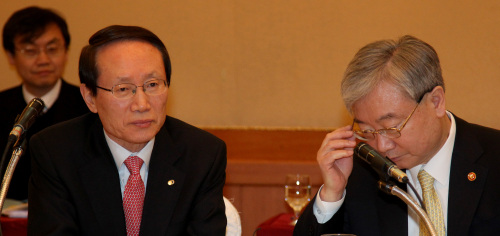Financial Services Commission Chairman Kim Seok-dong on Thursday pledged to take stern action against major shareholders of savings banks for illegal lending and excessive risk taking.
“Main shareholders engaged in unfair practices will face strict sanctions,” he said. “We plan to review major shareholders’ eligibility regularly and drive out of the market those failing to meet requirements.”
He made the remarks while unveiling a package of measures to normalize those smaller banks suffering from a credit crunch due to troubled real estate projects.
To protect the rights of customers of savings banks, the regulatory body will also enhance sanctions against businesses committing false or delayed stock disclosures, he said.
“We will instruct them to secure accounting transparency and public confidence.”
The nation’s chief financial regulator also expressed his determination to conduct restructuring of debt-ridden savings banks as early as possible.
He reiterated that those responsible for the insolvency could face civil and criminal punishment through the financial regulators handing them over to the prosecution.
Earlier in the day, in a report to the policy committee of the National Assembly, Kim said the FSC will step up supervision of savings banks’ risky practices including reckless lending.
In the report, the regulatory body said it will more tightly limit savings banks’ investment in risky assets, such as high-yield corporate bonds and excessive lending activities, as well as issuances of subordinated bonds.
Since the 2008 global financial crisis, many savings banks saw their capital health tumble due to their massive lending to constructors who failed to pay back loans because of a slumping property market.
The FSC has halted operations of seven savings banks since January. Though the seven savings banks saw their asset soundness stay at a critically weak level, the situation for buyers is favorable as financial regulators have proposed a method called purchase and assumption.
 |
Financial Services Commission Chairman Kim Seok-dong (right) and Financial Supervisory Service Governor Kim Jong-chang attend a session of the National Assembly Policy Committee at a hotel in Seoul on Thursday. (Yonhap News) |
Under the P&A, unlike in an ordinary M&A, buyers are entitled to acquire only the viable assets, not all of them, on a selective basis. They are also free of the obligation to retain a large portion of the savings banks’ employees.
Acquirers are likely to hand over the remaining non-viable assets to the state-run Korea Asset Management Corp. Eventually, the government-led restructuring of the secondary banking sector could end up injecting a sizable amount of taxpayers’ money into troubled savings banks.
The financial authority is expected to inject public funds to dispose of nonviable loans via KAMCO.
Among the potential buyers targeting them are KB Financial, Woori Financial, Shinhan Financial and Hana Financial.
“The process (to take over a savings bank) is under way,” the group’s chairman Euh Yoon-dae has said.
Regulatory officials of the Financial Supervisory Service expect that KB Financial, which has been evaluated as No. 1 in the local market, would be a competitive bidder for the troubled savings banks.
“It would be a desirable situation if the bidding competition among major financial groups would be fiercer,” an FSS official said.
Should big financial service companies acquire them, anxious sentiment among depositors of the suspended banks could be eased, he said.
By Kim Yon-se (
kys@heraldcorp.com)








![[Today’s K-pop] Blackpink’s Jennie, Lisa invited to Coachella as solo acts](http://res.heraldm.com/phpwas/restmb_idxmake.php?idx=644&simg=/content/image/2024/11/21/20241121050099_0.jpg)